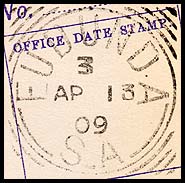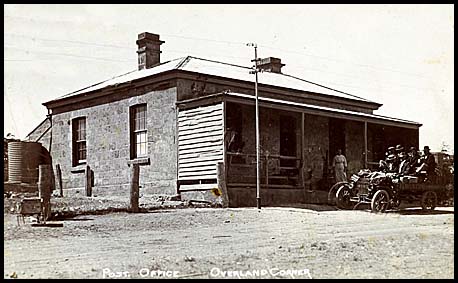Telegraph offices on the north-east lines.
- Site home & details
- Australia 1901-1988
- New South Wales
- Queensland
- South Australia
- Tasmania
- Victoria
- Western Australia
- International
- Special aspects
|
The Telegraph Office opened on 7 March 1866. In October 1865, the line was being pegged and the erection of the poles was about to start. In the South Australian Register of 9 July, 1868, the following small item appeared: "The Telegraph Office has lately been robbed twice of small sums of money; but there is a mystery about the affair, so that we can say little about it". In the House of Assemby on 13 October 1880, Mr. Basedow asked "whether the Government would, now the necessary money had been passed in the Estimates, go on without any unnecessary delay with the erection of the Post & Telegraph Office in Angaston. The Commissioner of Public Works said as the house had sanctioned the additional sum necessary, the work would be proceeded with as soon as possible". |
||
|
The Telegraph Office was opened in late 1865. On 2nd January 1866, the South Australian Advertiser noted that Blanch Town was one of five locations where "telegraph extension has been sanctioned".
|
||
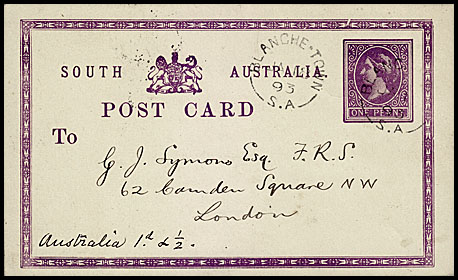 |
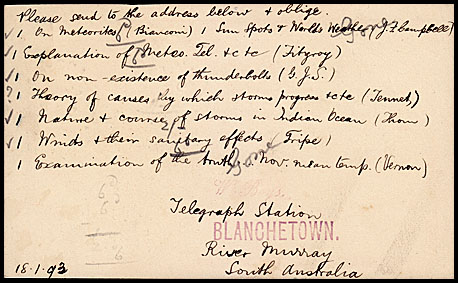 |
|
| A rare and wonderful momento of Blanch Town. The Postcard is to a Bookseller in London and was sent by the Telegraph Operator. He was requesting a set of books on atmospheric conditions related to telegraphic communication. There is n unframed date stamp of 18 January 1893 and a straight line hand stamp for the station on the reverse. | ||
|
The Telegraph Office was opened on 19 October 1877. Tenders were called for the construction of the Post and Telegraph Offices in May 1878. It was hoped that tenders would also be called for a Police Station - which was apparently "very much required". |
|
The Telegraph Office was opened on 9 October 1876. |
||
|
The Telegraph Office opened in 1864. The town changed name to Tweedvale in 1918. A new building was constructed in 1883 at a cost of £735. |
|
The Telegraph Office opened in 1866. |
|
The Telegraph Office opened on 3 February 1873. "It was a neat building; the walls are limestone, and the erection will consist of three private rooms and passage for Station master's residence, office, battery and storerooms. The building is in a fine elevated position, commanding a good view of the river both up and down stream". |
| Morgan.
|
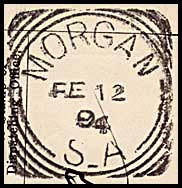 |
| Mount Pleasant.
The Telegraph Office was opened in 1867. |
| Tanunda.
The Telegraph Office was opened in 1866. The Foundation Stone for the building was laid at a well documented ceremony on 19 June 1865. It was established as an important repeater station serving Lyndoch and Nurioopta through to Stockwell and Truro. Greenock was added sometime later. From 1867, Tanunda was also part of the direct Adelaide-Wentworth-Sydney intercolonial line which also passed through the above stations (excluding Angaston and Greenock). The story of the appointment of a 14 year old boy named Schroeder in 1878 as a messenger at Tanunda gives a most revealing account of the operation and development of telegraphy in South Australia. |
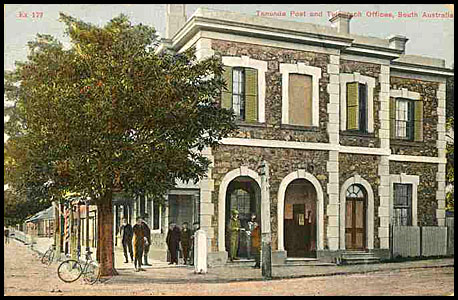 Tanunda Post & Telegraph Office 1909. |
|
The Post & Telegraph Office opened on 20 May 1880. On that day "the township was decorated with bunting, and a triumphal arch, bearing the words "Welcome to Teatree Gully" was erected across the main road, leading into the township ... the (telegraph) wires had run through the township but the difficulty of house accommodation stood in the way, and it was not until the Government purchased the old hotel on the hill that the difficulty was overcome ... (during the opening) The Post-Office clock was distinctly heard to strike, much to the astonishment of the residents". |
|
In August 1879, a Parliamentary delegation of 12 members inspected the building proposed for conversion into the new Post & Telegraph office. They had left Parliament House "in two traps" and arrived about two hours later. The building had previously been known as the Highercombe Hotel and it stood on the rise of a hill facing the East Torrens Road but a little way back. The Register noted that "It had been urged by some members that the building was totally unsuitable and was in a very rlcketty tumble-down condition, and whispers that a job had been perpetrated were circulated freely amongst those disaffected towards the Government." The hotel stood on 1.5 acres and had originally cost between £3,000 and £4,000 to build. It was sold to the Government for £600. The delegation arrived to inspect inside the building but were told the key had been left in Adelaide. "the irrepressible leader of the party was not easily daunted, however and, disappearing round an angle of the wall, soon beamed upon his anxious friends from the open doorway having burglariously entered the premises in a manner which still remains a dark mystery to the remainder of the party. The gates being thus opened, the little band of invaders meandered through the interior of the building, whose walls were found to be in a damp unwholesome state of decay. There are seven downstairs and six upstairs rooms, out of which it was stated the Government intended to accommodate Teatree Gully with a Local Court, a Post and Telegraph Office and quarters for a post mistress and a State school teacher. The Government also proposed to expend £200 in the rehabilitation of the building and, to an unprofessional eye, it certainly looks as if twice that money would not restore it to its pristine wholesomeness. The damp has apparently taken up a permanent abode in the walls, a sort of high tidal mark being visible all round them at a height of about three feet from the ground, and the flooring and woodwork is more or less ant-eaten, while the plaster and cement shows huge fissures and other tokens of instability. Still the site is a very good one ... After the party had inspected the building, Mr. Ward showed them out, and locking the doors from inside, made his egress as mysteriously as he had entered, not one of the party being able to discover how". |
|
|
The Telegraph Office opened on 20 November 1866. On 12 September 1878, it was reported that the foundation was being laid for the new Post and Telegraph office. |
